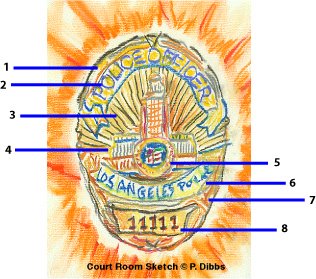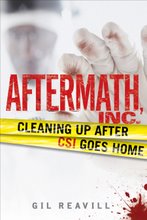MAFIA SUMMIT: Hoover, the Kennedy Brothers and the Meeting That Unmasked the Mob
A Non-Fiction Book by Gil Reavill
In November 1957, members of warring Mafia factions gathered to iron out their differences in the small upstate New York village of Apalachin. A lone law enforcement officer exposed the mob summit, forcing the government finally to admit that the country had a problem with organized crime. Packed with new research, featuring not only the bloody mob battles that led up to the gathering but the turf wars between Robert Kennedy and J. Edgar Hoover that followed it, Gil Reavill’s MAFIA SUMMIT is the definitive look at a turning point in America’s long battle against the mob. Thomas Dunne Books/St. Martin’s Press, WINTER/SPRING 2013.
Wednesday
Upcoming: GR's Non-Fiction Mob Book on the Apalachin Meeting
Posted by
Anonymous
at
1:58 PM
![]()
Thursday
Collaboration at the End of the World

Gil: I first met Rob Swan in spring 2008, and two weeks later I joined him on a ship traveling to Antarctica. It was, as Bogart says in Casablanca, the beginning of a beautiful friendship. Our collaboration has come to fruition with the publication of Rob's book: Antarctica 2041: My Quest to Save the Earth's Last Wilderness. The book tells the story of Rob's life, as a polar explorer who became the first man to walk to both poles (as Rob would amend that statement, "I was the first man stupid enough to walk to both poles"). It's a rollicking tale, as they say, full of ups and downs, tracing the author's progress until he finally arrives at his present-day position as a climate activist.
Posted by
Anonymous
at
9:18 AM
![]()
IN THE KINGDOM OF SHADOWS

Our new gig: working with ex-spy guy Edwin P. Wilson on his memoir. Ed's over 80-years-old now, but back in the day, he was a covert CIA field agent and bare-knuckle spook. Anyone who knocked around the docks of Hamburg and Marseilles (infiltrating labor groups) and sifted the dangerous sands of Gaddafi's Libya (selling the Libyan military weapons, while at the same time double-dealing them with his old contacts at the CIA) has got to have a little grit in his character. Not to mention spending 22 years inside federal supermax prison facilities, courtesy of a government campaign to ream, steam and dry-clean Edwin P. Wilson, the Spy Who Knew Too Much. If you've seen Syriana you've seen Ed in the George Clooney character (the real guy is a lot more handsome). This is from the non-fiction book proposal for the project that we're calling In the Kingdom of Shadows.
Please allow me to introduce myself.
I am Edwin P. Wilson; Edwin Paul Wilson; Ed Wilson the spy, the spook, the covert field agent; Ed Wilson Federal prisoner 08337-054; Ed Wilson the CIA’s man in Libya; Ed Wilson who’s been labeled a terrorist and bomber and traitor or worse in best-sellers and articles and commentary; Ed Wilson who was convicted of importing twenty tons of C-4 explosive into Libya packed in barrels of oil-drilling mud; Ed Wilson the international man of mystery, with a reputation blacker than the blackest ops, weapons trader, facilitator, hugely proficient professional creator of front companies for the Central Intelligence Agency; Ed Wilson the antichrist; Ed Wilson the martyr; Ed Wilson the spy who was hung out to dry; Ed Wilson, yours truly.
“Please allow me to introduce myself” – yes, I realize that’s the first line of the Rolling Stones song, “Sympathy for the Devil.”
Plenty of people consider me to be the devil incarnate. I’ve had a government official pronounce me “the most dangerous man in America.”
But whether I’m devil or angel or, like most people, someone somewhere in between, I’m not after your sympathy. I reject being labeled as a victim. I refuse to cast myself in that role. If I had, I never would have survived solitary lock-up.
Why would you read my story? What possible relevance today has a saga of out-of-control government power, Middle East skullduggery and corrupt officials desperately trying to cover up their incompetence and lies? But isn’t that a timeless saga, always relevant, the same one going down in Iraq today?
You might prefer to believe that the American government maintains at least a semblance of legality and a passing acquaintance with fair play. My story (and recent history) demonstrates otherwise. Any citizen, immigrant or foreign national, anyone at all, can get instantly, thoroughly, royally screwed at any moment by the whim of snotty law-school-graduate GS-12’s with too much power and too few scruples.
Some people won’t want to hear this saga because black and white is so much easier to deal with, even if reality is actually really herringbone. Or because it all happened thirty years ago, in another country, and besides the wench is dead.
Jack Nicholson in A Few Good Men: “The truth? You can’t handle the truth!”
But if you do want to hear it and can handle it, here it is, written in the pages of my book.
That's Ed today, with the painting behind him a souvenir of his prison past, painted by a fellow inmate at Marion Penitentiary in Illinois. The glowering shot up top is Ed's 1972 passport photo, for a long time the only known picture of him, the one circulated by Interpol when he was out on the lam.
Posted by
Specialist
at
10:49 AM
![]()
Monday
Pink Death Cameo

The Curtain of Pink Death made a brief but memorable appearnce in the AMC series Mad Men, near the end of The Mountain King episode, during the tarot reading scene in San Pedro. The meme continues to infect the cultural body electric at an inexorable pace.
Posted by
Anonymous
at
5:11 AM
![]()
Wednesday
WILD CHILD

Gil: I remember in the 1980s Tuli Kupferberg, the Fugs co-founder, cartoonist, all-around American anarchist and provocateur, put out a pamphlet he called "Child Pornography." It was page after page of black-and-white photos of child soldiers. As writers we've always been into the strange clash of violence and innocence (vio-cence?) of kid soldier culture, from clockers in Chicago to Kdogos in the Congo. Now we've got a project up and running that will help funnel all our passion about the subject into a screenplay, and rendered all the more interesting considering the news out of Colombia and Ecuador lately.
Right now we're calling it Child of God, after the Joni Mitchell lyric: I came upon a child of god/He was walking along the road/I asked him, Where are you going?/This he told me...
CHILD OF GOD
Treatment for a screenplay by Gil Reavill and Eric Saks
Adventure drama
Log line: After a ragtag crew of teenage soldiers take captive a wounded U.S. Army Reserve physician in South America, the doctor and the young warriors develop a complex but dangerous friendship.
Synopsis: Everett Fahey, 50, a middle-aged doctor conflicted about his role in the Army Reserve, joins an official humanitarian mission to northern Ecuador. He treats poor villagers but also CIA-funded mercenaries battling Colombian guerillas in the border territory. His risk-addicted behavior takes him ever deeper into the hot zone, where rival gangs of drug importers battle for turf.
In a blazing nighttime fire-fight, Fahey is wounded by a machete attack and left for dead. He regains consciousness as a prisoner of a teenage militia, none of the soldiers older than 15 years. His motor and speech capacity deeply impaired by the attack, Fahey is alternately tormented and nursed by Lorenzo, 15, the self-styled “Subcommandante” of the group. The orphaned Lorenzo is brilliant, Jesuit-educated, and he hides his adolescent neediness beneath a sardonic, macho exterior. Fahey slowly heals and his speech facility returns, while his relationship with Lorenzo and the other boy soldiers deepens.
As the CIA-funded mercenaries move in for the kill, Fahey must confront not only his conflicting allegiances but his own personal demons – to recognize the “child of god” within himself.
Posted by
Specialist
at
8:10 PM
![]()
Sunday
The Plan for World Domination Proceeds Apace
The Goodness Publishing House in Taiwan will publish a Chinese (Complex Characters) edition of Aftermath, Inc. Can't wait to see how they translate "ballpark figure" into ideograms. The title might be rendered 后果 if our handy-dandy online translator is correct. This seems to combine the ideogram for "bloody good" with the ideogram for "book," so it seems right. Along with the U.K. and Dutch editions of the book, and combined with the Russian and Polish versions of our film Dirty, it looks as though the Curtain of Pink Death might soon envelop the world.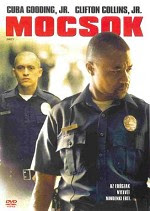

Posted by
Specialist
at
4:32 PM
![]()
Friday
The Ghost in the Machine

Gil: I woke up yesterday morning to discover that I had somehow become one of the top ghostwriters of the day. A dubious achievement, to be sure, but one I treasure even more because I am reading Robert Harris's new thriller, The Ghost. Harris is pretty hilarious (and dead-on) about the Zelig-like transformations, jaundiced compromises and questionable blandishments that are the ghostwriter's lot. In this passage Harris's unnamed ghost apostrophizes to his computer: "We had endured rock stars who believed themselves messiahs with a mission to save the planet. We had survived footballers whose monosyllabic grunts would make a silverback gorilla sound as if he were reciting Shakespeare. We had put up with soon-to-be-forgotten actors who had egos the size of a Roman emperor’s, and entourages to match."  Well, Tiki Barber had a lot more to say than Harris's (racist) metaphor might convey, and the rock star I'm working with isn't messianic so much as endearingly diffident. The metaphor I always use is a lawyer, providing a voice in court to those who don't know how to speak legalese. As everyone has the right to legal representation, everyone should have the opportunity to tell their story to a ghost. A trippier view of the ghostwriter (more politely and euphemistically called a "collaborative writer") comes in Philip Roth's The Ghost Writer, one of his best. Most recently, I helped Terri Irwin pen a memoir of her husband, Steve "The Croc Hunter" Irwin.
Well, Tiki Barber had a lot more to say than Harris's (racist) metaphor might convey, and the rock star I'm working with isn't messianic so much as endearingly diffident. The metaphor I always use is a lawyer, providing a voice in court to those who don't know how to speak legalese. As everyone has the right to legal representation, everyone should have the opportunity to tell their story to a ghost. A trippier view of the ghostwriter (more politely and euphemistically called a "collaborative writer") comes in Philip Roth's The Ghost Writer, one of his best. Most recently, I helped Terri Irwin pen a memoir of her husband, Steve "The Croc Hunter" Irwin. In fall '07 Simon Spotlight Entertainment published Tiki: My Life in the Game and Beyond, by Tiki Barber with Gil Reavill. That followed Ruthless: A Memoir, by Jerry Heller with Gil Reavill. This all came in the wake of my original collaboration, the New York Times best-selling Beyond All Reason: My Life with Susan Smith, by David Smith with Carol Calef (written with my wife, and credited pseudonymously to our middle names).
In fall '07 Simon Spotlight Entertainment published Tiki: My Life in the Game and Beyond, by Tiki Barber with Gil Reavill. That followed Ruthless: A Memoir, by Jerry Heller with Gil Reavill. This all came in the wake of my original collaboration, the New York Times best-selling Beyond All Reason: My Life with Susan Smith, by David Smith with Carol Calef (written with my wife, and credited pseudonymously to our middle names). The only common thread I can pick up in this quartet of authors is that they all wanted their stories told. My friends make fun of me for always becoming such an enthusiastic fan of my subjects. And the job of ghostwriting does require something of the Zelig sensibility. But I would want my lawyers to believe in my case thoroughly before they ever venture into court, especially if it was my life (or my biography) that was on the line.
The only common thread I can pick up in this quartet of authors is that they all wanted their stories told. My friends make fun of me for always becoming such an enthusiastic fan of my subjects. And the job of ghostwriting does require something of the Zelig sensibility. But I would want my lawyers to believe in my case thoroughly before they ever venture into court, especially if it was my life (or my biography) that was on the line.
Posted by
Anonymous
at
7:46 AM
![]()
Thursday
Secret Handshake Grasps Aftermath

Producer Dena Hysell and the folks at Secret Handshake Entertainment are developing Aftermath, Inc.: Cleaning Up After CSI Goes Home into a feature. Dena has successfully run multiple entertainment companies, inside the studio system and independently. She began her career at Gold Circle Films (My Big Fat Greek Wedding, White Noise), and moved on to run Just Singer Entertainment. Most recently, she ran the feature side of Slate of Eight (principal Alan Jacobs; American Gun, Nina Takes a Lover), where she developed a dozen film projects in budget ranges from three million to eighty million dollars.
Posted by
Anonymous
at
8:05 AM
![]()
Friday
Praise for Aftermath, Inc.
“A crime classic.”
Jason Kersten, author of Journal of the Dead
“An interesting, quick-moving book that gives the reader a true glimpse into the world of murder and mayhem.”
Stephen McCaskill, CSB: Crime Scene Blog
“Violence on steroids...a funny and oddly soothing guide to Aftermath, Inc., a company that cleans up the gore at crime scenes after the police have finished with them.”
Anne Stephenson, Arizona Republic
“...Utterly absorbing and interesting. A unique look at investigations and what happens after. It proves that truth really is stranger than fiction... While I wouldn’t want to do what Reavill did, I sure was fascinated reading about it.”
Jon Jordan, Crime Spree magazine
“...a fascinating read... Gil Reavill leaves no gory detail untold, no victim or clean-up technician unprofiled, and he does it all with a certain morbid flair."
Jessa Crispin, Bookslut
“I enjoyed this book... Believe it or not, it occasionally made me laugh. If you’re curious-but-not-dainty, a true-crime fan, or if you believe that TV is a real representation of life, Aftermath, Inc. is a book you’ll be dying to read.”
Terri Schlichenmeyer, syndicated newspaper book review
"When Aftermath concentrates on pure reporting, it is gold. Reavill is a self-deprecating narrator.... His descriptions stem from a sharp eye for the smallest detail...Reavill's reportage and curious nature allow for an emotional heft....When CSI goes home, much of the real work begins, and Reavill's ability to show just how far-reaching and important this work is makes Aftermath, Inc. a fascinating read."
Sarah Weinman, Philadelphia Enquirer
“A deeply thoughtful and well-crafted meditation on the meaning of the messiness of life when it is viewed through the lens of the messiness of death...Reavill writes about crime scenes with a staggering depth of interest that outshines the rote formulaism of the contrived crime shows. Reavill’s passionate interest in literature, music, history, philosophy, biology—all things human—informs his approach to coping with the horrifying messes and tragedies he confronts throughout the book. Most importantly, Reavill is a deft storyteller... Highly recommended read, but not during lunch.”
D.A. Kolodenko, San Diego CityBeat
Posted by
Anonymous
at
8:44 AM
![]()
Sunday
Monday
Rock Stars Of The Afterlife…

 Eric: I had a big hand, a kind of slight of hand, with the The Prestige DVD. Now in stores on 2/20.
Eric: I had a big hand, a kind of slight of hand, with the The Prestige DVD. Now in stores on 2/20.
What I quite like about Christopher Nolan’s The Prestige, is his vision, a foresight that includes all the creatives and talent who conspired to tell a story about a time and place not dissimilar to now, a world in turmoil, searching for bigger truths.
I think the period culture in the movie is so rich texturally that it is almost an epic. The movie manages to depict a new era zeitgeist at the crossroads of a fin de siècle, an amorphous London full of conflicting desires born out of war and the spectacle of new sciences transforming the world; a sea change crashing in without the purview of Christianity.
But, critics focused, mostly, on the lackluster of the story's big reveal “magic trick” in The Prestige compared to the “trick” in The Illusionist, that are in both cases, cinematic slights of hand to the audience. Or, cinema pundits have merely zeroed in on how The Prestige’s story is about obsession as it too was one theme in the book. I think Nolan really wanted to show that magicians of the day were the rock stars of the time—to achieve that, he could have shown more of the audience reaction and awe to the conjuror theatrics.
Everyone interviewed for the making of documentary, the Featurette as is it is more femininely called, had quite interesting things to say about their research for the movie. DVD documentaries being what they must be, meant that only so much of the deep and brainy ideas discussed in interviews could fit into the editorial without making a feature in itself. I tried to put in as many revelatory insights as I could.
And, funny, I can’t remember all that went into the final cut of the DVD documentary of The Prestige, but here is a bit from Hugh Jackman, who so interestingly talked about background of the movie during the original interview on set: 
Hugh Jackman (Angier) :
“There was, this era that was fascinating because you have to understand that in America at this time, spiritualism was a greater religion than Christianity. So there were more spiritualists than there were Christians. And leading up to and post WWI because so many people died, the obsession with contacting the afterlife, being in contact with séances so on, informed magicians acts and what made them seem incredible. If you remember with WWI; I mean it decimated the male population of most of these countries so many people were obsessed with being in contact with the other world, the afterlife and magicians seemed to offer that as a real possibility. And so many of the shows, not only did they have death defying feats, and things like chaining themselves up, and drowning themselves, and being under water and life threatening situations, there was a lot of ghosts coming to life, you saw a lot of that stuff on stage and magicians was where it started. It then translated to the theater. People used magicians, like Thurston's stuff , they used bits from his stage show to do Macbeth, the ghost of Macbeth. I think magicians back then are now the people who do special effects on movies. I mean, these guys were incredible engineers, their imaginations were incredible and they were given this impossible task and told let’s see if we can make it happen and you see that on a movie set almost every day.”
Well, seeing the DVD (all the extras on it) is like seeing and experiencing a different version of the movie; it sometimes is like seeing the movie and reading the book that the movie came from, hearing a radio show conversation about the movie and spying in on how things really happened to make the movie.
Posted by
Freckle E
at
8:01 PM
![]()
Saturday
Aftermath Ink

Reactions are coming in from the folks to whom Gotham Books sent galley proofs of Aftermath, Inc. Check it out:
Luc Sante, author of LOW LIFE
Gil Reavill's Aftermath, Inc. is at once sprightly, grave, morbidly fascinating and conducive to contemplation. It is about the wide consequences of crime and it is also, vividly, about what people will do to earn a living.
Kathy Reichs, practicing forensic anthropologist, author of BREAK NO BONES, producer and creator of the Dr. Temperance Brennan character featured on the hit TV series "Bones"
Stimulating and brainy, Aftermath, Inc. amounts to a thinking-person's guide to scenes that are either hidden from sight or slashed across news screens. A fascinating and entertaining book.
Kim Wozencraft, author of THE DEVIL'S BACKBONE
The first suicide case I worked as a cop took place in a kitchen. There was blood everywhere, bits of skull and brain matter splattered on the walls. As we left the crime scene, I asked another officer if he knew who would clean up the mess. He said there were a couple of firemen in town who hired out for that kind of work when they were off-duty.
By turns bizarre, gruesome, philosophical, and humorous, Aftermath, Inc. is a fascinating look at crime and death as seen from a most unusual angle. I couldn't put it down.
Linda Fairstein, former chief of the sex crimes unit in the Manhattan District Attorney's office and author of the Alexandra Cooper mysteries
Aftermath gets into the underbelly of the beast that is violent crime and takes on a terrifying tour.
Posted by
Anonymous
at
11:44 AM
![]()
Friday
Hard Body

We got these hella kool body-armor vests. We got ‘em off one of the Google AdSense links that kept pop’n right here on this blog. Why do we need body armor? We think wearing body armor is a good tactic for pitching our new two-hander about "ATF" agents (ATF is now ATFE – E for Explosives, only they didn't add the E to the official acronym because of budgeting since all the feddy $ goes to the Department of Homeland Security) So, back to the story. Our ATF agents (without the E) go up against some mad bombing skills in an onion-layered conspiracy. You shoulda seen the look in the eyes of the D-girl taking notes on the side of the room.

So, if you wanta get yourself some ultimate pitch vests, go here: INTERAMER
Posted by
Anonymous
at
4:09 AM
![]()
Thursday
Writing Between Trees Produces Results

Eric was a recent fellow at the MacDowell Colony in the fall of 2006. During a splendid but all too short idyll amidst the whispering maples, birches and New Hampshire pines, he completed a new draft of his co-written (+Gil) feature screenplay, Joshua Tree, which he hopes to direct.
Eric also developed and wrote several short film projects, that Gil and Eric went on to further rewrite through the fall of 2006. He is now producing one of these film shorts in 2007, entitled Cupcake, about an abducted child who escapes from their captor.
Posted by
Freckle E
at
2:28 PM
![]()
Tuesday
Aftermath, Inc. Excerpted

The excellent literary periodical Maxim just contracted to excerpt Aftermath, Inc.: Cleaning Up After CSI Goes Home in its May issue. Editor Jason Kersten (a brilliant writer in his own right, and author of The Journal of the Dead) called the book "a crime classic" and is putting together a crime-photo heavy lay-out. So everybody out there who insists they only look at Maxim for the photo spreads will have something to read.
Posted by
Anonymous
at
6:29 AM
![]()
Monday
Mike S. Ryan on Misguided Liberals
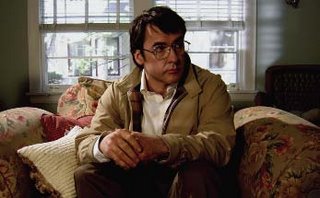
Check out our pal Mike S. Ryan (Junebug, Palindromes, Forty Shades of Blue) on the perils of soft-headed, well-intentioned thinking in his post on Grace Is Gone, a new John Cusack film that premiered at Sundance.
"Donald Rumsfeld and all pro-war Republicans will love the new John Cusack film, Grace is Gone. Others, some whom may be liberal, agree: it could be a crowd-pleaser able to reach beyond the indie ghetto. It was bought earlier this week for $4 million.
"Rumsfeld will love how the film shows a family coping with the grief following the death of the family's soldier mom. There is no anger at the film's end; we are left feeling that this grief will be healed. The film offers a positive portrait of how a family can pull together in such sad circumstances.
"Rumsfeld will love how the film's one dissenting, anti-war perspective is mouthed by a clichéd liberal couch potato. Alessandro Nivola plays a 31-year-old bearded lay about. We see him in mid-afternoon on his mother's couch, dozing off in front of cartoons. This liberal also has unfocused opinions, no ambition, and is really only concerned with eating. And being unable to pay for his own meal, living in his mothers home, he is seen as mooching off the system.
"Rumsfeld and most Republicans will agree with Cusack's response to his older daughter's questions about the war. To question the value of the war would lead one to a scary place, "we'd be lost," he says. Better to stay the course and trust that the government has our best interests in mind.
"Cusack may think that by showing grief and the pain of a soldier's loss, he's made an anti-war film. He couldn't be further from the truth. In fact, he may have inadvertently made a pro-war, pro-Bush film. I think all Republicans will endorse Grace Is Gone; it does not question the war's purpose, instead it focuses on how the country will get through this difficult period.
"Assuming the filmmakers are liberal -- and don't intend to come off as supporters of Bush or the war -- how do we explain these sloppy aesthetics? The filmmakers have said they want to reach the biggest audience possible; they feel the subject of their film is nonpartisan. Truth is, though, there is nothing nonpartisan about the war: you either support it or feel that it was a tragic mistake, one that has resulted in countless innocent Iraqi and American deaths.
"The 'nonpartisan' excuse is really just a cover-up for the fact that the goal of the film is to make as much money as possible. Profit drives its aesthetics, just like profit has driven this war. In this sense the film is the worst kind of exploitation film -- a film that profits off the unjust deaths of innocents is a heinous, odious thing. Like war profiteers Rumsfeld, Cheney, Rice, and Bush, the filmmakers proceeded ahead without truly and fully thinking out their strategy and understanding the consequences of their choices. But as with Halliburton and Bechtel, their choices will very likely result in enormous profits for them and their clan.
"Shame on all war profiteers. And please, let this be a warning to all liberally minded filmmakers: let's think out our choices carefully before proceeding with a war-themed film. We may end up doing more harm than good."
Read all the comments on the Filmmaker Magazine site to gauge what a tempest Mike stirred up.
Posted by
Anonymous
at
12:30 PM
![]()
Murder of Crows on 2/02/2007
Even when you work on a movie doing only the BTS (behind the scenes) documentary coverage, it can be years before you see anything on screen, and I mean, any kind of screen, whether it be on the interweb or mobile phone screen.
So, alas, The Messengers, directed by Danny and Oxide Pang, is hitting theatre screens, finally; and all the BTS I (Eric) produced and directed on it is out there somewhere in the digital ether.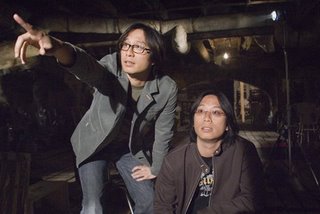
Here are a few links to see my work for the movie: The Messengers Webisode "Pang Vision"
( go to the "video" section ) And... Ghost House site (Mr. Rami's horror production Co)"
I directed 10 webisodes and 10 mobisodes (for G3 phones in Europe and Asia.) but because of the unknown vagaries of the movie industry only certain BTS webisodes are still around – one main reason is the webisodes gave away a lot of details about the story and effectively were spoilers, revealing too much about how scary the movie is. Also, they re-shot and changed the movie a whole bunch after I did webisodes on principal photography.
One thing I liked about checking these tag-team directors in action is, that besides pinch hitting for each other in the directing dept. (one brother one day and the other brother the next day in the director’s chair), these twin-bros directors would direct a scene, even a single beat, according to how they saw it edited in their head. So, on set, you’d invariably here Danny or Oxide yell “Cut,” right in the middle of an actor’s performance of a line because they knew they’d be on someone else’s face in the editorial; then, they'd move on to the next set-up on their shot list.
I knew about this directorial style as a way to save money in production from reading about Hong Kong films, but to see it in action really blew my mind. It blew the actor’s minds to say the least. I think it might be the first Hollywood film that was directed in this style.
Posted by
Freckle E
at
7:51 AM
![]()
Saturday
Still Our Favorite Review

Dirty
A Silver Nitrate Releasing release. Produced by David Hillary, Tim Peternel. Executive producer Ash Shah. Co-producer, Tierre Turner. Directed by Chris Fisher. Screenplay, Fisher, Gil Reavill, Eric Saks.
Salim Adel - Cuba Gooding Jr.
Armando Sancho - Clifton Collins Jr.
Lieutenant - Cole Hauser
Baine - Wyclef Jean
Capt. Spain - Keith David
Brax - Wood Harris
Roland - Robert LaSardo
Manny - Lobo Sebastian
Taboo - Ramirez
Splooge - Khleo Thomas
Rita - Aimee Garcia
(English, Spanish dialogue)
By ROBERT KOEHLER
The cop genre receives a shot of adrenaline in helmer Chris Fisher's "Dirty," a no-nonsense dramatic response to the LAPD Rampart scandals of the '90s. Pairing a transformed Cuba Gooding Jr. and Fisher favorite Clifton Collins Jr. as morally compromised beat cops enduring a bad day on the streets is just the start of film's smart moves. By handing theatrical release reins (for spring opening) to exec producer Ash Shah's Silver Nitrate, Sony has missed an opportunity to earn serious coin with a pic that should have terrific crossover appeal among multicultural aud niches, though studio (which holds vid rights) will enjoy bang-bang ancillary returns.
Though it was never conceived as the finale of a trilogy, Fisher's latest completes a rough and very raw cycle of Los Angeles crime movies, starting with true-life serial killer dramas "Nightstalker" and "Hillside Strangler." While he retains certain touches of shock and horror -- along with a decibel-busting soundtrack -- from earlier pics, Fisher takes huge strides forward in "Dirty," fashioning a complex morality drama that overshadows films with similar themes from "Training Day" and "Crash" to "Dark Blue."
Collins' Officer Sancho narrates, in classic Los Angeles cop fiction style, the story of his dangerous transformation from gangbanger to cop. But on a sunny, yet grimy, day (brilliantly and seamlessly lensed in smog-stained color by Eliot Rockett and Danny Minnick), Sancho is on the brink of coming clean with LAPD's Internal Affairs department about his involvement in drug-related corruption in his division, led by Capt. Spain (Keith David).
Sancho's partner Adel (Gooding), so thoroughly corrupt that his upside-down nametag is a symbol of his rottenness, has no idea that Sancho is talking to IA cops, who are also investigating Sancho for accidentally killing a bystander during a shootout.
Spain, along with his nefarious Lieutenant (Cole Hauser), view the gang-infested streets as a war zone where any tactic is suitable, even if it includes ordering Sancho and Adel to remove a 13-kilo bag of heroin from an evidence room to frame Canadians horning in on the business of drug kingpin Baine (Wyclef Jean). Sancho rightly views the assignment as rife with traps, but he can't control Adel's urges to harass and abuse civilians, from white out-of-towners to Venice homies.
For a movie that stays true to its low-budget roots as a decidedly prol genre work, "Dirty" draws a vast panorama of Los Angeles street life and the similar hierarchies that rule black and Mexican gangs as well as the LAPD. There's always some higher authority to answer to, just as there's always another hidden agenda designed to bushwhack the unsuspecting foot soldiers, whether or not they wear a badge. It's this parallel of criminal and law enforcement elements, along with its pointed portrait of non-Anglo cop partners on quite different moral paths, that distinguishes pic from other recent genre works.
Just as a certain fate seemed to hang over the serial killers in his previous thrillers, a dark cloud looms over Fisher's cops here. This inevitability unfolds with genuinely tragic power, not only because of Fisher's confidence in his material but also because of Gooding and Collins' lusty embrace of their roles.
Collins adds to his fascinating gallery of portraits of bad men -- or, in this case, extremely flawed men -- internally tortured by their actions, but Gooding is a revelation. His Adel is a nasty and self-hating cop who has been so undone by what he's witnessed on the beat. It's just the tonic for an actor who has drifted into too many goody-goody roles since "Jerry Maguire."
Supporting cast is studded with extremely vivid perfs, including the always magnetic David in his best role in years, Jean in colorful overdrive (and speaking a Jamaican patois that's subtitled) and Robert LaSardo dominating a finale sequence rife with unbearable tension.
Pic looks and sounds fabulous, with Fisher showing off his love of soundtracks layered with noise, quiet and bone-rattling music. Los Angeles is a major star in the film, and with no iconic or familiar sights on view, it's framed as only a local is able to.
Camera (color, Super 16mm-to-35mm), Eliot Rockett, Danny Minnick; editor, Tracey Wadmore-Smith; music, Peter Lopez; music supervisor, Greg Danylyshyn; production designer, Anthony Rivero Stabley; art director, Chris Davis; costume designer, Johnny Wujek; makeup effects designer, Robert Hall; sound (Dolby Digital/SDDS/DTS), Jim Dehr; sound designer, John Marquis; supervising sound editor, Marquis; special effects supervisor, Chris Bailey; visual effects, Digital Domain; supervising stunt coordinator, Dain Turner; police technical adviser, Chris Craig; line producer, Richard Middleton; assistant director, David Cluck; casting, Shannon Makhanian. Reviewed at AFI Los Angeles Festival, Nov. 10, 2005. MPAA Rating: R. Running time: 97 MIN.
Posted by
Anonymous
at
6:56 AM
![]()
Curtain of Pink Death

"Hey, what's up with that curtain thing?" asked a fellow human being about our signature image on emails and posts. Curtain of Pink Death Productions is an umbrella d/b/a for our movie and screenplay work. And "curtain of pink death" was the sobriquet that referred to the nether parts of a mutual girlfriend of ours. But the image itself Eric found on the web, provenance unknown. Or maybe it appeared to him in a dream. Meditate on it long enough, and you will find yourself eternally marooned in a hallucinatory bardo in which mimicry passes for life.
A view of a generic biege-pink brick-shuttered McMansion seen through a window on a lightly stained recently curbed concrete street, with a curving sidewalk nobody ever walks on leading across a threadbare, newly re-landscaped lawn. The naked shivering tree, a brutalist marker for housing development existentialism. The pot of flowers, a lone bit of color, to the left of the front door, looking as though it were dropped off there by a realtor lady working on half commission. Blank-faced double-garage doors, hiding either a meth lab or a collection of never-ridden bicycles, des vélos de ville solides, conçus pour la rue.
And then, on this side of the belvedere, the curtain itself, draped and tied in a uterine way, suspended from a faux-brass rod from Home Depot, occluding washed-out, insipid, afternoon light from the biege-painted drywall of an unseen room. "What cannot be said," wrote Jim Harrison in his notebook, "will get wept."
In the bottom left corner, a digital date stamp in red: 2006 4 27. Of no significance, unless you remember April 27 was the day Kepler fixed upon as the date for the creation of the universe, in 4977 B.C., which would be 6,983 years before this snap was shot. Could the precise timing of the curtain of pink death photograph indicate the re-birth of the universe into a new, all-biege, all-homeostatic reality? Or was the date stamp merely an ironic comment on the detached, still-born suburban meringue in which our countrymen's lives have become irretrievably clotted? You decide.
To come: the CGI animated version of the image, with the curtain billowing in a hand-of-God wind, courtesy of Eric Saks.
Posted by
Anonymous
at
5:36 AM
![]()
Thursday
Old Poem

Gil: I turned this up sifting through old papers recently. I wrote it in college, at the University of Colorado. My writing teacher at the time, the poet and playwright Sidney Goldfarb, said this poem would "be remembered when someone like Robert Creeley is long forgotten." He was wrong, but it was quite a generous thing for him to say. I don't know what he had against Creeley. Pagoda Mountain is in Rocky Mountain National Park, above Boulder. It's in the middle of the photo above right.
THE WINDS AROUND THE PEAK OF PAGODA MOUNTAIN
Down from the peak of Pagoda Mountain, winds blow
Clouds the color of honey across the rough face.
We've come to Sandbeach Lake to spend the night,
And sprawl on the sand, laughing loud drunk
Or fiercely preserving the silence. Four or five
Rainbows idle in the shallows, a mongrel cries
In the jackpines by the shore. We count stars
As they come out, one, two, suddenly
We hallucinate thousands, blinking
And slipping out from under our count
Like trout. We drink more wine, forget
About the sky, never notice when the winds
Around the peak of Pagoda Mountain
Blow loose the stars into darkness.
The roly-poly Goldfarb and I had a somewhat tortured history subsequently. He took off for Europe on a summer sabattical in 1979, and had me house-sit his cabin in the canyons above Boulder, near a small hippy hamlet called Wall Street. Sidney had already left when I moved in, and the first thing I noticed was that his stereo and all his record albums had vanished. A bad omen at the beginning of my stewardship, but I sort of fecklessly considered that perhaps Sidney had taken his tunes with him to Europe (or Yurrup, as Pound used to spell it). I spent an idyllic time at his cabin. We had a lot of wine-stained dinners and created a sweat lodge in the mouth of an old mine-shaft just up the draw from the cabin. Things might have gotten away from me. When the estimable Professor Goldfarb returned from estivating abroad, he was dismayed to discover that the front door to his cabin was wide open with no one at home. An oversight on my part. He discovered his albums missing, and other irregularities: a few colorful woolen blankets he had purchased in Mexico were now stained with black charcoal, a consequence, I fear, of our sweat lodge adventures. Goldfarb cooled to me. In fact he never spoke to me again, and gave me the stink-eye whenever we passed each other on campus. A friend of mine, whom he picked up hitchhiking, made the mistake of telling him that she knew me. He pulled over to the side of the road and made her get out of his car.
That "mongrel" in line six has a story behind it. A group of friends, Paul Rogers among them, did indeed head for Sandbeach Lake one weekend to ingest hashish and forget how to count. Paul brought his dog Oliver along. Strictly forbidden to have dogs within the confines of the park, of course, a Federal rap, in fact, if you're caught. So on the way up we concoct a story, agreeing on a false address in case we were stopped. We enjoy a glorious night at Sandbeach Lake, and Oliver howled at the coyotes in the Ponderosa pines ("jackpines" scanned better, even though there is none in the park). On our way down the trail the next morning, sure enough, we encountered a park ranger. He busted us on the dog. Summoned each one of us away from the others down the trail twenty yards, giving us the fifth degree to see if our stories matched. They did, fake address and all, except I forgot the agreed-upon house number. Oops. Smokey wrote us all summonses and let us go, after verbally ripping into us with righteous naturalist anger.
Posted by
Freckle E
at
10:16 PM
![]()
Saturday
DIRTY = Rampart = C.R.A.S.H = Hansel and Gretel
Notes from the co-writers of Dirty, directed by Chris Fisher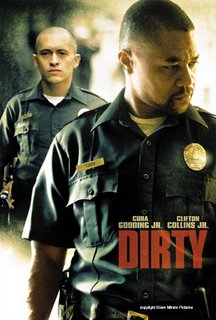
November 2005.
GIL: Do you remember our first spit-ball sessions on Dirty? You always told me that in the land of the LAPD there are one million stories to tell.
ERIC: I had dug into news reports about police corruption, and fixated on an LAPD officer named Rafael Perez, who in 1999 threatened to tell all one million of those stories.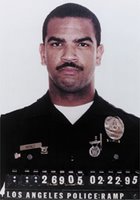
GIL: I couldn’t believe it – here was a cop who had stolen SIX POUNDS of cocaine from a police evidence locker. So Perez gets immunity from prosecution in exchange for testifying about a sweeping pattern of misconduct by “dirty” cops.
ERIC: Perez’s tales threatened to overturn thousands of LAPD conviction cases, costing the city of Los Angeles millions. Perez also pointed fingers at about seventy fellow CRASH officers during his grandstand days in court.
ERIC: So then…
GIL: …Chris Fisher comes into the picture.
ERIC: I knew Chris through my friend Elliott Rocket, the cinematographer on Dirty. Fish is a director who made some very interesting films about crime, one of which made Sundance.
GIL: Fish asked us to come up with a story about the LAPD CRASH unit shenanigans after reading my Rampart scandal article from Maxim magazine about Rafael Perez.
ERIC: CRASH, that stands for Community Resources Against Street Hoodlums.
GIL: I love police acronyms!
ERIC: Fish’s mandate for Dirty was to have us deal with how absolute power corrupts absolutely. Within an all-powerful organization such as the LAPD, the ones who get punked the most are its own foot soldiers, the guys on the street.
GIL: We thought the title “Dirty” would be perfect for a film about corrupt cops.
ERIC: In the movie, fictional cops Armando Sancho and Salim Adel are undercover warriors sent on a fool’s errand. They get punked, but they achieve some measure of redemption, too.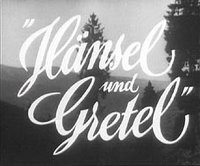
GIL: Do you remember who brought Hansel and Gretel into play? Was it you?
ERIC: It was Chris.
GIL: We thought he was off his rocker! But it proved exactly right. First off, I fucking hate seeing people say Dirty’s just like Training Day. Because Dirty is way deeper than an errand boy-cop-buddy punks newbie-buddy-cop. The plot we hatched is more Machiavellian.
ERIC: Chris Fisher told us to think of it as a Hansel and Gretel story. There is direct allusion to H&G in the first few minutes of the movie as Adel’s kids watch an animated Hansel and Gretel cartoon.
GIL: The L.A. powers-that-be send these two lost children out into the dark woods of the city, hoping that they would just get gobbled up.
ERIC: We decided to take the Hansel and Gretel model back beyond the sanitized middle-class 19th-century versions to the medieval core of the fairy tale. In the Middle Ages it was a common practice to commit infanticide because of the constant shortages of food. Brother and sister, Hansel and Gretel, are left in the woods to die because the parents can’t feed ‘em.
GIL: Our early drafts of Dirty were way more dark than what the story is now. Remember the exploding microwave?
ERIC: And how Rita put her lipstick on the bullets she intended for Adele?
GIL: The cops in Dirty are dirty, but they are most definitely NOT rogue cops, because they have the full endorsement of command, a top-down license to manufacture “crime reduction” at any cost. Get the public approval ratings and make the front-man mayor look good.
ERIC: I always loved the character of a gangbanger with an attack of conscience.
GIL: Or a dirty cop with an attack of conscience. Sancho is both!
ERIC: What happened was that Fish took our script, stripped it down, added his magic to it, and then cast some of the greatest actors in movies to give it life, improve it, improvise around it. But what you see up on the screen…
GIL: That’s our movie, right?
ERIC: Right.
FROM GIL AND ERIC: To Cuba Gooding, Clifton Collins, David Keith, Cole Hauser, Aimee Garcia, Wyclef Jean, Taboo and all the cast members, to Chris Fisher, Elliot Rockett, Ash Shah, Tim Petrenel and everyone else involved, you are incredible, and you made an incredible film.
Posted by
Freckle E
at
5:54 PM
![]()
LAPD Badge Deconstructed
2 -- 20 YEARS "ON THE JOB" RETIRE WITH FULL PENSION
3 -- MASONIC SUNBURST LINKED TO TEMPLAR CONSPIRACIES
4 -- ABU GHARIB PRISON (LOCAL BRANCH)
5 -- PROTECT (OUR OWN ASSES) AND SERVE (UP ASS WHUPPINGS)
6 -- STATE-SPONSORED INSTITUIONALIZED TERRORIST UNIT
7 -- FASCES -- MUSSOLINI'S FAVORITE SYMBOL
8 -- BADGE NUMBER (OFTEN OBSCURED WITH ELECTRICIAN'S TAPE)
(Jan 2006.) Our courtroom sketch artist connection fed us this...
And, as Adele says in Dirty, "Number one, motherfuckging rule is that you run, you get a beat down."
Posted by
Freckle E
at
1:15 PM
![]()
Friday
Skyhead in "Wildfire" film
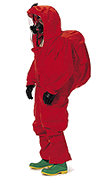


November 2005. Yes, the rumors are true. Eric continues to shoot bit by bit, his H5N1 Avian Flu saga, his film "Wildfire" with his monster muse "Skyhead."
STORY SYNOPSIS: "Wildfire"
In an apocalyptic world plagued by a lethal airborne virus, two men battle each other to win the attention of a woman – Only one will survive.
Posted by
Freckle E
at
5:30 PM
![]()
Ruthless Book Proj.

10/10/05. Reavill: In time for my birthday, the long-aborning JERRY HELLER MEMOIR PROJECT finally got sold to Simon & Schuster’s Spotlight Entertainment imprint. This’ll be a ass-kicking project that will set the hip-hop world on its collective ear.
Check out the flap copy: “PAYBACK’S A BITCH, JERRY.”
The words scrawled crudely across Jerry Heller’s bedroom mirror that afternoon meant the rap wars had suddenly escalated. In the battle of his life over the ragingly successful music label he helped found, Ruthless Records, Heller had seen death threats, extortion, strong-arming, and beatings. Now the violence had come home when his enemies burglarized his house, jacked his Corvette, and left behind this sneering piece of graffito.
Heller didn’t get mad, he got even. Ruthless tells the explosive story of Jerry Heller’s alliance with Eric Wright, a.k.a. “Eazy-E,” one of the legends of rap music and a founding member of “the world’s most dangerous band,” N.W.A. As a long-time music industry super-agent, Heller had the skill and insight necessary to guide N.W.A.’s comet-like rise to the top of the charts. Along the way there were raucous nationwide tours, out-of-control MTV pool parties, and X-rated business meetings. Heller held on through the brutal shocks and reversals of the Ruthless Records era, which saw the label being targeted by the F.B.I. and its principal artists locked in back-stabbing and betrayal, until a final turnaround placed Ruthless at the top of the heap once more. Always in the middle of the whirlwind were Jerry and Eazy, an odd-couple pairing that represents one of deepest and most appealing stories in American music.
You don’t have to be an N.W.A. fan to love Ruthless. Heller turns the music industry inside out, exposing its strange logic and larger-than-life personalities. Ruthless provides keen insight into the popular music scene, with an unforgettable portrait of its rollicking excesses, life-churning drama, and multi-million-dollar highs.
RUTHLESS A Memoir
The Explosive Tell-All Memoir of a Maverick Music Mogul with an Ear for Talent and a Talent for Controversy
by Jerry Heller with Gil Reavill
BACK FLAP COPY:
Across five tumultuous decades, Jerry Heller has helped shape American popular music, breaking new talent, developing new trends, and forging an industry-wide reputation as “the guy who gets there first.” He rose to prominence in the 1960s as a “super-agent,” ranking with such legendary names as David Geffen and Freddie Fields, importing Elton John and Pink Floyd for their first major American tours, representing Journey, Styx, REO Speedwagon, Boz Scaggs, The Grass Roots, Guess Who, Marvin Gaye, Joan Armatrading, Van Morrison, War, Average White Band and Crosby-Nash.
In the mid-80s, Heller was the moving force and marketing genius behind the world-wide emergence of West Coast rap music. He not only founded Ruthless Records with the late Eazy-E, but discovered or managed N.W.A., Egyptian Lover, World Class Wreckin’ Cru, L.A. Dream Team, Black-Eyed Peas, J.J. Fad, Above the Law, Rodney O and Joe Cooley, the D.O.C. and Bone Thugs 'N Harmony. Dollar for dollar the most successful music executive of the rap era, Jerry Heller continues to work and prosper in a changing music business. He lives in Calabasas, California with his wife Gayle, sister-in-law Vicki, and their four dogs, three cats, and a parrot.
READ AN EXCERPT HERE: X
Product Details
Simon Spotlight Entertainment, September 2006Hardcover, 336 pages
ISBN-10:
ISBN-13:
Posted by
Freckle E
at
2:02 PM
![]()
Wednesday
The Dirtiest Cop Alive Maxim article
The Dirtiest Cop Alive
Nov 2000. Maxim Magazine. by Gil Reavill
Los Angeles police officer Rafael Perez was part of a ruthless task force charged with eliminating gangbangers from the city’s terrorized streets. So how did the cops become monsters themselves?
Joey Tenorio, the scrawny 14-year-old junior gangbanger everyone called L’il Silly, tried to stay calm as he stood handcuffed to the second-floor railing in the abandoned rathole at 11th and Lake in downtown Los Angeles. It was a bright day in early August 1997, but he had to force himself to keep from shivering. He was terrified.
Tearing through the house like a shitstorm were a dozen LAPD cops from the Rampart Division’s antigang detail, called CRASH—Community Resources Against Street Hoodlums. He recognized them from the gaudy patch some wore on their uniforms: a grinning white skull with deep black eye sockets, wearing a cowboy hat with a silver LAPD badge on the brim. Fanned out in the background were four cards—the deadman’s hand of aces and eights. Everyone on the street knew to fear that insignia and anyone who wore it. Word was these guys were worse than any gang.
According to Tenorio, the two cops who’d cuffed him—Brian Hewitt, the buffed-out one with the dirty-brown Fu Manchu mustache and the wild eyes, and Ray Perez, the intense one who seemed to be calling all the shots—stomped upstairs with the rest of the CRASH unit to clear the upper floors. On the way up one of the cops kicked Tenorio square in the head as he walked past him. As Hewitt and Perez trooped back down, they booted him upside the skull again.
He watched nervously as the big freak Hewitt took out a black felt-tip pen and drew two concentric circles on the plaster wall of the hallway. He couldn’t figure it out at first, until the goddamn cop inked in a center circle.
“You don’t give me a gun, and your head’s gonna go right through that bull’s-eye,” Hewitt promised L’il Silly.
“I don’t know where I can get you a gun,” Tenorio cried.
Wrong answer. The two cops uncuffed him from the railing and recuffed his hands behind his back. Perez and Hewitt each took one of Tenorio’s arms and lifted his 90-pound body easily. Then they hurled a battering ram consisting of the head and body of Joey Tenorio hard into the target. The impact made a flat, smacking sound and bent Tenorio’s neck back at a crazy angle. When they pulled him away from the wall, the plaster cracked and crumbled and a jagged hole roughly the size of Li’l Silly’s cranium appeared in the bull’s-eye.
“Tell me about the gun!” Hewitt demanded.
“I don’t know about a gun!” the kid screamed.
The cops smashed Tenorio into the target over and over until the wallboard busted apart and they were ramming him into the two-by-fours underneath. He felt blood trickle from a gash in his head, then gush. He tried not to pass out, even as the splinters of wood sliced into his skin and embedded themselves deep beneath his scalp.
Welcome to Rampart, kid.
The Thin Blue Line
The assault on Joseph Tenorio triggered no immediate official investigation. Officers Perez and Hewitt never entered the event into their memo books. It was, in fact, just an ordinary day in the City of Angels’ most hellish police precinct.
The Rampart Division of the LAPD covers eight square miles of misery just west of downtown. Poor and mostly Hispanic, the densely packed area is home to more gangs than any other part of L.A.—60 in all, with about 8,000 members battling for turf. For years, bodies littered the streets. To fight fire with fire, a city-wide antigang unit, CRASH, was created and given a simple, all-encompassing mandate: Clean up the mess, no questions asked. The CRASH motto was “We intimidate those who intimidate others.” For a time in the mid-90s, gang violence in L.A. plummeted. But at what cost?
Last fall, the stunned citizens of L.A. began to find out. Two years after he used Joey Tenorio as a battering ram, Rafael Perez became the central figure in one of the worst police- corruption scandals in U.S. history. In 50 hours of gripping testimony given to investigators, Perez painted a chilling picture of brutal, rogue cops working far outside the law. The elite officers of Rampart, he said, planted evidence to get convictions, sold drugs, and unlawfully beat and even murdered suspects.
Few of the cops, investigators concede, may have been worse than the whistleblower himself. “One of my clients told me he’d rather meet Satan in a dark alley than Rafael Perez,” a lawyer representing Rampart victims said to Court TV. On February 25, 2000, Perez told a judge: “Whoever chases monsters should see to it that in the process, he does not become a monster himself.” But just how did Perez—and much of an entire division in the nation’s largest police force—become more evil than the criminals they pursued?
Baptism by Blood
Rafael Antonio Perez was born in Puerto Rico to an absent father and a tough, hard-working mom. He moved to the U.S. while he was still a kid and soon became obsessed with cop shows like Adam-12. He joined the Los Angeles Police Department in 1989 at age 21, and prospered right from the start.
“Perez was a glory hound,” says a senior officer who had him under his command. “The guy looked like a great officer, but it was all about himself—the highest gun take, the highest number of narco busts, the highest felony arrests. If he wasn’t in the thick of it, he wasn’t interested.”
Assigned to the West Side Narcotics Bureau after some quick promotions, Perez partnered up with the star of the unit. David Mack was a smooth operator who’d learned street smarts the hard way, growing up in Compton. Mack had run his way out of the ghetto, winning a track scholarship to the University of Oregon and becoming an NCAA 800-meter champ. He almost married fellow sprinter Florence Joyner. But by 1988, at age 27, he’d lost his world-class wheels and joined the LAPD.
Mack and Perez worked undercover in some of the worst neighborhoods in east L.A. Mack seemed to know everyone. Perez, just 25, idolized his partner, picking up Mack’s taste for cigars, designer suits, and mistresses.
“Ray was impressionable and young,” remembers his wife, Denise, who met Perez while working as a department dispatcher. “He really looked up to David for his street sense.”
On October 26, 1993, Mack and Perez sealed their partnership in blood. That night they rolled up to Jesse Vicencio, a crack dealer with the Clanton 14th street gang. The two cops were acting as “buy dogs” for an undercover narcotics sting.
Vicencio, dusted up on PCP, acted nervous and jerky. Suddenly, in the middle of the deal, he threw the cash Perez had given him back into their car.
“Nah, man,” he said. “Are you Bloods or Crips?”
Perez, riding shotgun, tried to do damage control. “Come on, man, I’m just a basehead,” he said. “Take it easy.”
Vicencio began to back away. Suddenly, say bystanders, David Mack was reaching past Perez with a .38. He thrust it out the window, then he began squeezing off rounds. He hit Vicencio in the scrotum and in each thigh. The gangbanger staggered away toward the middle of the street and clutched his midsection while blood began to seep through his clothes, warm and sticky. He turned to run. More shots, in rapid succession. Two hit Vicencio in the left arm and one went through his back, tearing up his innards. One more bullet entered his chest, puncturing his right lung and aorta.
After 13 shots in all, Vicencio died in front of 2137 Cambridge Street, the house where his parents, wife, and young daughter lived. He never fired a round, and according to witnesses, may not have even been armed.
The LAPD investigated the incident, as it does every “O.I.S.”—officer-involved shooting. Vicencio, the investigation concluded, pulled a gun first. They nominated Mack for a medal on that one. Ray Perez came out a hero, too. But Perez was restless. He wanted something bigger.
Initiation into a Secret World
The more Perez heard about CRASH, the more he wanted in. Created in the 1980s as a last-line defense against the vicious drug-related gang violence threatening to engulf the city, the department’s 20 paramilitary-style CRASH divisions were culled from the best street officers the LAPD had to offer. The units were given breathtaking autonomy, with little oversight.
For Perez, there was only one problem. You couldn’t just join a CRASH unit as though it were some neighborhood gym. You had to be sponsored in. But Perez had an ace: Sammy Martin, Mack’s former partner, was an active CRASH officer, and he agreed to recommend Perez for his detail—the CRASH unit at Rampart.
Even in the harsh realm of CRASH, the 20-member Rampart unit stood out. “They were tough and crazy,” says Rafael Zambrano, a former member of the Playboys gang, who more than once was on the receiving end of a CRASH beating. “They were there to kick ass.” And they got results.
Ray Perez arrived at Rampart CRASH in August 1995. His first impression was that he had joined a particularly hard-partying fraternity—Animal House with semiautomatics. Perez dove headfirst into its rituals. “There was always going to be some type of bachelor party,” Perez recalls. “It just depended on who we would pick to be the bachelor that day.”
Most of the blowouts were held in one of the unit’s “CRASH pads”—places near the precinct house used to hothouse mistresses, hookers, drugs, and copious amounts of booze. One was an apartment in the Valley donated in return for the increased security that a cop presence would provide.
The parties had a tendency to get out of control fast. Even as everyone was getting trashed, the CRASH veterans watched Perez carefully. They were leery of the new recruit. For his part, Perez was eager to prove that he was “in the loop”—he inked the same grinning skull tattoo that other CRASH officers had, matching the patches on their uniforms.
Soon Perez’s loyalty would be put to the test for real.
Getting in the Loop
As soon as Perez hit the sidewalk in front of the Shatto Place apartments the night of July 26, 1996, all hell broke loose. Shotgun blasts boomed from the interior, sounding like cannons. Perez didn’t waste time. He tore up the front stairwell and almost tripped over the wounded body of a gangbanger, Jose Perez. Officer Michael Montoya had him covered, so Perez didn’t even slow down.
More blasts echoing from upstairs. Just as Perez got to the third-floor hallway, he saw Juan Saldana, a member of the 18th Street gang, fall over backward. He’d been hit in the “10 ring,” or dead center in the chest. Another blast had ripped through his back. Above him stood Officer Kulin Patel, his semiautomatic still drawn.
“Decock and holster,” Perez shouted to the frozen Patel. Perez inched forward to put the cuffs on Saldana. Just then officers Brian Hewitt and Doyle Stepp burst into the hallway from upstairs.
“Shit!” Hewitt said, looking at Patel. “Kulin got him.” He and his partner Stepp had been pursuing Saldana through the building. Now the guy lay bleeding at their feet, going into shock. “What’s going on?” mumbled the dying Saldana.
It dawned on Perez: No gun. Saldana was unarmed.
“Shit!” Hewitt said again. He and Stepp disappeared upstairs, returning seconds later. Stepp carried the butt of a pistol by his fingertips. He dropped it next to Saldana.
Then they showed Ray Perez how it was done. Led by their sergeant, Eddie Ortiz, the CRASH officers huddled up in the third floor hallway. Nobody else was allowed near the scene.
Planting a gun was an art, one the officers of CRASH had down cold. The “throw-down gun,” they explained, was always loaded, with a bullet racked in the chamber—a loaded gun carried a higher penalty. Also, CRASH cops routinely filed off the guns’ serial numbers, since that made possession into an instant felony.
The cops huddled together as Juan Saldana bled out a few feet away. Finally an ambulance was called, and Perez led the barely conscious, handcuffed Saldana downstairs. Medics met them at the first floor landing, but Saldana died shortly after.
“Before I arrived at Rampart CRASH,” Perez later told investigators, “I had never put a gun on a person. When you get to Rampart CRASH, this is something that you’re taught.
“Once you’re in the unit,” he added, “certain things have to happen before someone can say, ‘Yeah, you can depend on him, he’s in the loop.’” No question, Perez was now in the loop.
That night after the shooting, the CRASH cops partied at the Short Stop, their favorite bar, until 6 a.m.
New Blood
That summer Ray Perez got a new partner, a guy he sponsored into the unit. Nino Durden knew enough to play second fiddle. He let Perez, who spoke Spanish, do most of the interrogations while he booked evidence. But he had a mean streak.
On October 11, 1996, Durden and Perez were set up in an OP, an observation point stakeout, in apartment 403 of a huge abandoned apartment building downtown. They were looking for 18th Streeters with guns. The place stank of piss. Inside, they found a 19-year-old named Javier Ovando.
The two cops handcuffed Ovando and dragged him into a darkened, trashed-out apartment. According to an account told much later by Ovando, Perez and Durden began interrogating him. Things quickly went straight to hell. Ovando refused to cooperate, enraging both men. Suddenly Perez pulled his Beretta from its holster and fired it directly into Ovando’s chest; moments later, Durden shot him in the chest also. The blasts sounded enormous in the tiny space. Ovando lay moaning and bleeding, sprawled backward toward the door. Then Perez grabbed him by the front of his shirt, pulled him off the floor, and shot him point-blank in the head.
Amazingly, Ovando was still breathing. “Hold on a second,” Durden said, running off. When he returned, he carried a filthy red rag. He let it fall open and a gun tumbled out, clattering down next to Ovando: A TEC .22 semiautomatic with a banana clip that they had confiscated a few days earlier.
Javier Ovando was paralyzed from the waist down. Convicted of assault on a police officer, he was wheeled into his sentencing hearing strapped to a hospital gurney. The judge scolded Ovando for what he characterized as a total lack of remorse and gave him a prison sentence of 23 years.
A Reign of Terror
Rampart CRASH was too strapped for personnel to send many supervisors out into the field. The cops were just unleashed on the streets, more and more in plainclothes, and everyone—police hierarchy and citizenry alike—turned their backs. Throughout the spring of 1997, Perez and Durden slipped deeper into the dirty bath of street drug culture, barely noticing that the level was rising over their heads.
Perez took a mistress straight off the streets, a big-breasted drug informant named Veronica “Bela” Quesada. At the same time she was seeing Perez, she became involved with Ruben Rojas, one of the leaders of the Temple Street gang.
Rojas knew the CRASH unit well. In 1994 they picked him up in an alley, then threw him in the squad car and drove into the rival 18th Street Gang’s territory. The cops made Rojas take his shirt off—revealing his gang tattoos—and pushed him out of the car. Then they switched on the loudspeaker.
“Temple Streeter walking by!” they announced.
Ruben tried to run, but it was futile.
“Next thing I know I got 10 motherfuckers on me,” he said. “I got stabbed in the arm two times, in the stomach. My jaw was broken and so were two of my fingers.”
In the spring of 1997, shortly after Ruben had gotten out of prison on armed robbery charges, he and Quesada began seeing each other. When Ray found out, he went ballistic.
A few days later, Rojas was sitting at home in his boxer shorts watching Free Willy on video. He didn’t recognize the voice when he picked up the phone and heard some guy speaking half English and half Spanish. “Don’t you know it’s bad to be messing with somebody’s novia?” the caller snarled.
Five minutes later, his front door crashed open and CRASH cops flooded into the house. They slammed Rojas down to the carpet. Perez stood over him and shoved a shotgun into his face. “Motherfucker,” he yelled, “make a move and you’re a dead son of a bitch!”
The cops, about four of them, furiously ransacked his house, screaming and turning everything upside down. They found nothing.
Perez didn’t know what to do with Rojas until an old friend climbed up the steps and entered the house. It was David Mack. He had dropped by the neighborhood and thought he would help out his old buddy Perez.
“Bring him in,” Rojas recalls Mack saying.
Sitting in the station’s interrogation lockup, Rojas saw Perez emerge from the evidence room holding a yellow envelope with a bulge in the bottom. “This is what you’re going down for,” Perez said. “These are your drugs.”
Perez nailed Rojas for six years state time, effectively eliminating a gang leader and a rival in love at the same time.
Where the Money Is
In May 1997 Nino Durden and Perez made a clean arrest. They confiscated a shoebox stuffed with the holy trinity of the coke trade—money, drugs, and pagers. After returning to the Rampart station house, Durden sat in an unused interview room and counted the cash. Perez walked in on him.
“Man, there’s $1,000 in here,” Durden said.
Perez paused for a moment.” Yeah, well, shit, we ain’t gotta book all of it.” Durden booked $500. He and Perez split the other $500. There was no turning back now.
During a bust that summer, Perez took a pager and a white paper bag filled with cocaine off a suspect. The bag contained 24 ounces of coke, already rocked up. As he prepared to book the coke as evidence, the beeper went off.
Perez looked down at the number on the display, and looked back up at Durden. Why not?
Perez made the call. Pretending to be a dealer, he set up a meeting with the potential buyer, fully intending to arrest him when they met. But as he and Durden were driving to the rendezvous, Durden came up with a better idea.
“Screw it, let’s just sell to him,” Durden said. After two more deals, they ended up pulling in $10,000 from the bag.
Desperate Measures
If things were spinning out of control for Ray Perez, he had plenty of company. His old partner Mack was in the West L.A. precinct, a flashy neighborhood that contrasted sharply with his own financial plight. Mack knew it wouldn’t be easy to support a wife and two kids on a cop’s salary of $55,000, but he never thought it would be this hard.
In private he started speaking cryptically about planning a major crime. “I could kill you in your apartment and nobody would ever know.” he told his girlfriend, Errolyn Romero.
As winter 1997 approached, Mack became more and more desperate. His credit card bills had reached $17,000, and he owed the IRS more than $20,000.
On the morning of November 6, 1997, Mack dressed in a dark business suit, a cloth hat and dark sunglasses. A little after 9 a.m., he entered the Bank of America on West Jefferson Boulevard, just across the street from the USC campus.
Mack seemed to know his way around the bank. It helped that the branch assistant manager was his girlfriend, Romero.
Romero got Mack into the vault, where two tellers were at work. Once inside, Mack turned nasty. Sweeping an M-11 assault rifle from a sling inside his jacket, he screamed at the bank employees not to touch their emergency pagers. “Don’t get yourself killed for money that doesn’t belong to you,” he shouted. Scooping up almost three-quarters of million dollars in shrink-wrapped packets, he got away clean.
Mack went on a spending spree that was extravagant even by his standards. He took his two former partners, Sammy Martin and Ray Perez, to Las Vegas to see Michael Moore fight Evander Holyfield for the heavyweight belt. They never got around to the fight. Instead, they checked into a luxury suite and hung out at Caesar’s Palace, smoking $100 cigars, drinking, living the highlife. For the occasion Mack wore a bright-red designer suit, complete with a matching top hat.
Back in L.A., Mack continued to splurge. He bought car stereo gear, leather furniture, and a Chevy Blazer. He paid off some loans and deposited $7,000 into his bank account.
The investigation into the robbery almost immediately settled on Romero. She had ordered a large shipment of cash the day before the robbery. She failed a lie-detector test.
Under intense grilling, Mack’s girlfriend finally caved. She slid a business card across the table to investigators. Printed on it was the name, DAVID MACK, LAPD.
Stealing from the Cops
Back in Rampart, things were going from bad to worse. After Mack’s arrest, Perez became paranoid that he was being investigated by the feds. But between the stolen dope he sold and the dope money he stole, the payoff was just too sweet to stop. He had his girlfriends, his gambling, his family. He began substituting flour for some of the coke he confiscated before he checked it into the evidence locker. But it still wasn’t enough. By early 1998, he’d graduated from ripping off drug dealers to ripping off the LAPD. He would check out large amounts of coke under other cops’ names. “I need this,” he would tell the clerk, and she’d get it for him. It was a snap.
Ray Perez ultimately got tripped up not because he stole drugs or because he planted evidence and framed gangbangers. The fall of Ray Perez happened because he was rude.
Laura Castellanos, an officer in the Property Division, remembered Perez’s nasty attitude five months earlier when he checked out an item for use in court: three kilos of cocaine, wrapped in cardboard. When a search of the evidence room showed pounds of coke had disappeared under the LAPD’s noses, police chief Bernard Parks enacted a secret task force to investigate. Castellanos picked Perez out of a photo lineup.
On August 6, 1998, detectives searched his house, his Ford Explorer, and his work locker. They found nothing, and Perez refused to cooperate further. He was taken off active duty.
Three weeks later, SWAT teams blocked off Rafael Perez’s quiet suburban street, search dogs were brought in, and he was arrested for the theft of close to eight pounds of cocaine.
C r i m e s and Punishment
The first trial against Perez resulted in a hung jury. He decided not to roll the dice on a second trial. Looking at a sentence of 12 years for the coke heist, Perez didn’t like what he saw: a dozen years in state lockup, doing time with many of the same gangbangers he had beaten, robbed, and framed.
Perez called his lawyer. He brokered a sweetheart deal: a reduced sentence of five years and immunity from other charges for full testimony. And so Perez talked. And talked some more.
Perez’s searing testimony, delivered over four months from September of ’98 through January of ’99, blew the lid off the dark world of CRASH. By the time he was finished, four more officers would be arrested, and 70 cops would be put under investigation. Among those who went down were Brian Hewitt, Nino Durden, and Edward Ortiz, who was later accused of quarterbacking the whole operation.
Prisons across the state had to throw open their doors, freeing Ovando, Rojas, and many others. Almost 100 cases have been overturned; up to 4,000 may wind up back in court.
In spring of this year, police chief Bernard Parks formally disbanded all CRASH units. This August, a federal judge ruled that the LAPD could be sued under RICO statutes, essentially declaring that the LAPD is a criminal enterprise.
The ruling increased the city liability to staggering proportions. Already, Mayor Richard Riordan earmarked the city’s $300 million tobacco settlement to pay off gang members whose civil rights were trampled. It might not be enough.
On February 25, at his sentencing hearing, Perez tried to explain his actions to an outraged public. “The lines between right and wrong became fuzzy and indistinct,” he said in an unwavering voice. “I stepped over that line landing with both feet sometimes on innocent people. It didn’t occur to me that I was destroying lives.” Ray Perez remains in protective custody in a Los Angeles County jail, from where he recently informed his lawyer that he has found God.
David Mack got 14 years in a federal prison for the bank robbery but never told the authorities where he had stashed the major part of the money. Mack has been transferred to a federal prison in the Midwest, where he has repudiated his police past and claimed heavyweight gang connections.
Rojas, the ex-gang member who was framed for drugs, says he crossed paths with Mack as he was being transferred from one prison to another. As Rojas sat across the hall from Mack, he passed the former cop a note, asking, “How does it feel?”
He never got an answer.
—Additional reporting by Laurina Gibbs and Charles Rappleye
Posted by
Freckle E
at
11:51 AM
![]()

